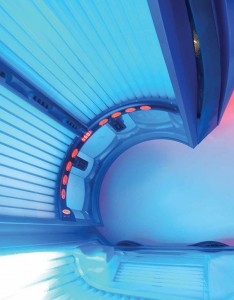 They’re tempting, tantalizing and, of course, tanning, but the siren song of indoor tanning beds covers up one important fact: they are also dangerous.
They’re tempting, tantalizing and, of course, tanning, but the siren song of indoor tanning beds covers up one important fact: they are also dangerous.
Proponents of tanning beds often advertise that their “sunshine” is safer than the real thing, as their beds primarily emit UVA light. This allows you to naturally build a tan, so that you are less likely to burn when you expose yourself to actual sunshine. Most salons also have UVB beds or pods which will further deepen your tan.
Many people frequent tanning salons just prior to a tropical or semi-tropical vacation, believing that the colour they develop will protect them from burns when they arrive at their destination. In fact, a salon tan is the equivalent to an SPF of 2 to 4 and should never replace the use of a sunscreen with appropriate SPF. (This is dependent on your natural skin and hair colour and how long you plan on staying in the sun, but an SPF of 30+ is generally recommended.)
You may also hear the message that indoor tanning is healthy as it allows your body to produce vitamin D (the sunshine vitamin) without the risk of burning associated with “real” tanning. While it is true that, in climes such as ours, vitamin D deficiency is a very real possibility, taking an inexpensive vitamin D supplement is a much safer way to go.
UV light, vitamin D and skin cancer
Low levels of vitamin D have been linked to a number of cancers including breast, prostate and colon cancer. However, whether there is a direct causal effect has not been studied and so remains unknown. No studies have as yet shown a definitive link between various types of skin cancer and low levels of vitamin D.
What remains a certainty is that both UVA and UVB light increase risk for all skin cancers – from the common and less dangerous basal cell carcinoma to the often-deadly squamous cell carcinoma and melanoma.
The enhanced risk of malignant melanoma is particularly worrisome as it is on the increase and spreads fast, reaching the lungs and other organs in just a few months. The Canadian Cancer Society projects that close to 6,500 new cases of melanoma will be diagnosed Canada-wide this year, and that close to 1,050 Canadians will die from it. (This is up from 5,300 new diagnoses in 2009 and approximately 940 melanomarelated deaths.) UVA light is perceived by researchers to be more carcinogenic (cancer-causing) than UVB light.
In 2011, the World Health Organization (WHO)’s International Agency for Research on Cancer moved indoor tanning beds to its highest cancer risk category, Group 1 “carcinogenic to humans.”
Home tanning beds and sunlamps used for tanning are, of c o urse, also included as carcinogenic devices.
Who is most at risk?
People with fair and/or freckled skin that tends to burn are at higher risk than those with darker colouring. Young people also have delicate skin and are more likely to damage it using sunbeds. You should never use a sunbed if you:
- are under 18*
- have fair skin
- are freckled or have a lot of moles
- burn easily • have a family history of skin cancer
- use medication or supplements that increase your sensitivity to UV light (your London Drugs pharmacist can provide you with information on the many drugs and supplements that may photo-sensitize the skin)
A healthier salon service
Many tanning salons offer sunless tans, which are perfect for going away on vacation (just remember to wear your sunscreen of SPF 30 or higher when you arrive at your vacation destination.) There are two kinds of sunless spray tans: an instant bronzer and a DHA (dihydroxyacetone) tan which develops over a few hours. DHA is derived from sugar cane and beets, and reacts with the amino acids in the skin to create the darkening reaction.

